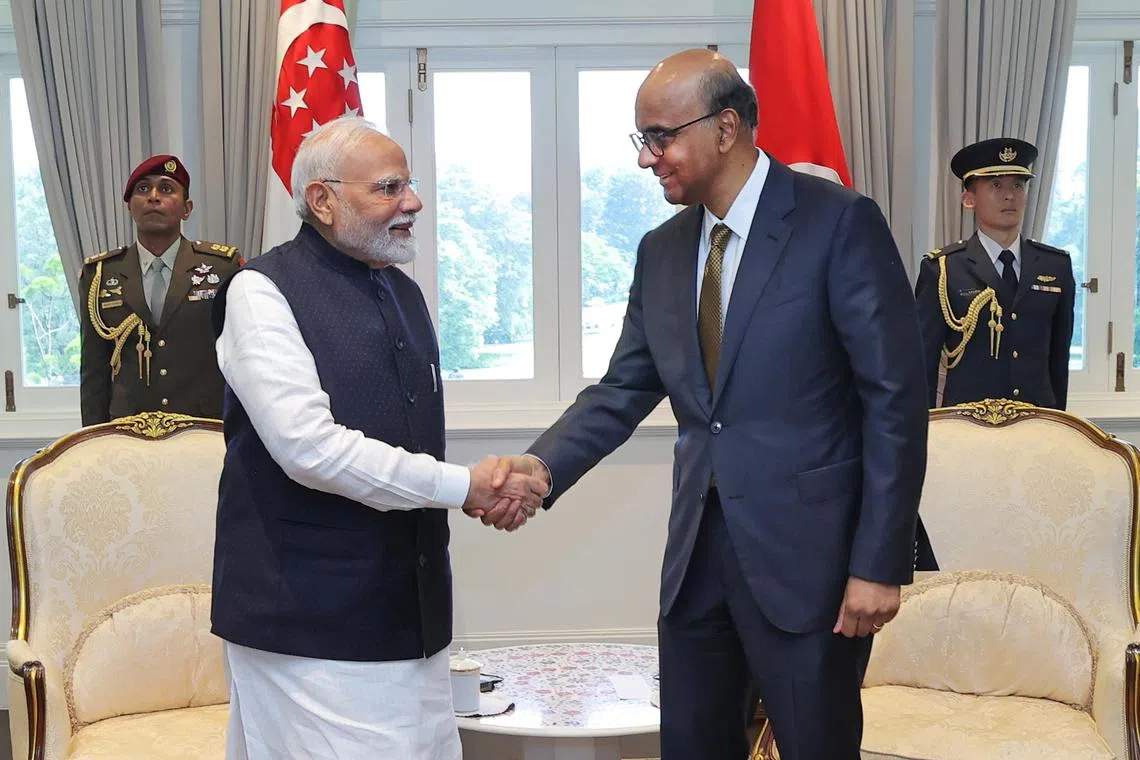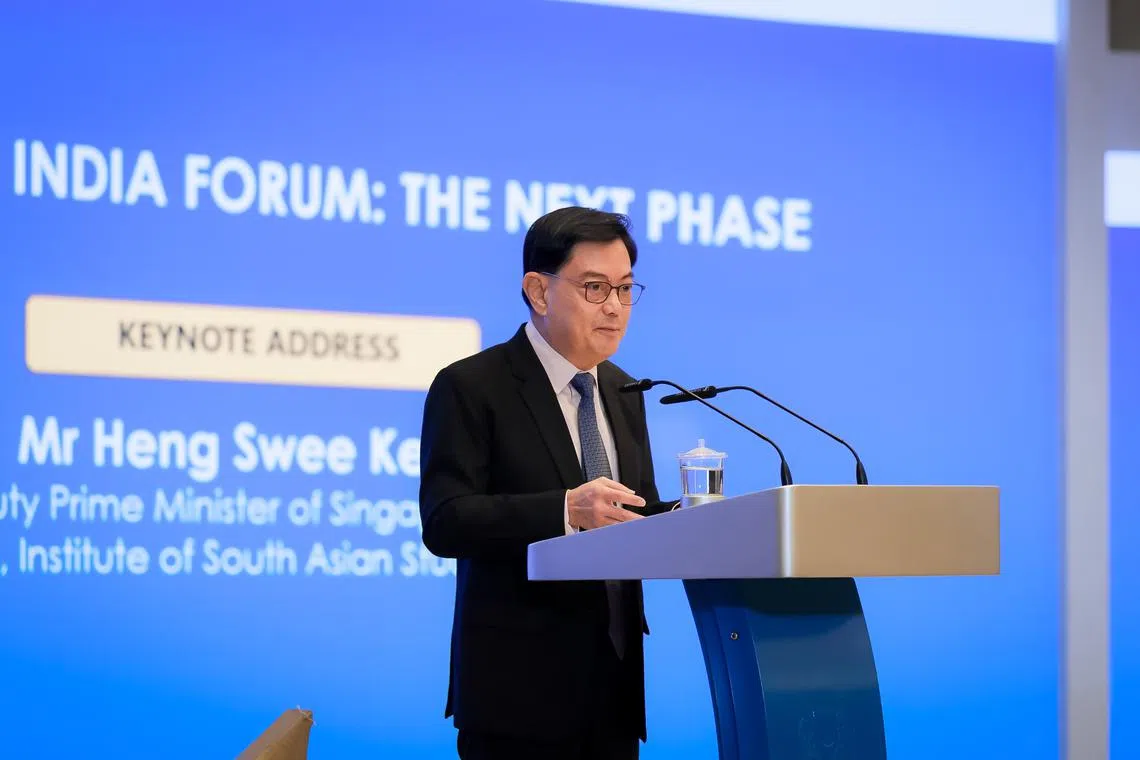Singapore-India partnership a beacon for like-minded countries, says DPM Heng
Sign up now: Get ST's newsletters delivered to your inbox

Indian Prime Minister Narendra Modi (left) called on President Tharman Shanmugaratnam on Sept 5, 2024.
PHOTO: MDDI
Follow topic:
SINGAPORE – Singapore and India’s longstanding partnership can serve as a beacon to rally like-minded countries to cooperate for growth and development in a more contested world, Deputy Prime Minister Heng Swee Keat said on Sept 5.
The steady ties could also encourage the countries’ partners around the world to harness technology and innovation, and to deepen trust and appreciation for each other’s diversity, he said.
“We are confident that continued bilateral exchanges such as Prime Minister (Narendra) Modi’s visit today will unlock many new opportunities for collaboration that will benefit not only our two countries, but also the wider Asean and Asian region and others globally,” said DPM Heng.
Mr Modi was on an official visit to Singapore from Sept 4 to 5,
DPM Heng was speaking at the inaugural Singapore India Forum, held at The Fullerton Hotel. Themed “The Next Phase”, the forum was organised by the Singapore chapter of the Singapore-India Partnership Foundation, the NUS Institute of South Asian Studies (ISAS) and the Singapore Business Federation.
Elaborating on what this next phase could hold for Singapore-India collaborations, DPM Heng shared three suggestions on how the two countries could shape and steer towards even more impactful outcomes.
“First, economic growth will remain a work in progress – it is never done, and in fact, will become more complex,” said DPM Heng, who is ISAS’ patron.
“To advance our growth and development, Singapore, India and the rest of Asia must continue to strengthen our economic connectivity and integration, to allow for capital, ideas and talent to find their optimal uses,” he added.
In this regard, the significance of the Comprehensive Economic Cooperation Agreement (Ceca) inked between India and Singapore in 2005 is not just in deepening economic linkages between the Republic and New Delhi, he said. Annual bilateral trade has grown by 2.5 times, from $20 billion in 2005 to $51.2 billion in 2022, since the agreement was signed.
He said Ceca’s wider value is to serve as a pathfinder for other agreements that foster closer economic ties between India and Asean, and India and other Asian economies.
This was borne out in the signing of pacts such as the Asean-India Trade in Goods Agreement in 2009, and a Trade in Services Agreement and Investment Agreement inked between New Delhi and the bloc in 2015.

Deputy Prime Minister Heng Swee Keat said the two countries' steady ties could encourage the countries’ partners around the world to harness technology and innovation.
ST PHOTO: GAVIN FOO
Collectively, as a region, Asia “must build the right capabilities to stimulate growth and unlock new opportunities”, DPM Heng said. “This leads to my second observation – that technology will be a decisive advantage to the next phase of partnerships between Singapore and India, and the rest of Asia.”
He gave the example of how technological innovations had helped India leapfrog in the development journey, with the nation’s Aadhaar identity card proving to be a game changer in terms of bringing millions of people digitally into the economy, and helping them benefit from social support schemes.
He observed that Singapore and India have been early movers in leveraging technology for cross-border connectivity, with the link-up of Singapore’s PayNow and India’s Unified Payments Interface in February 2023, allowing real-time payments between people in both countries.
Earlier on Sept 5, the two countries agreed to deepen digital cooperation, including in enabling data flows, digital public infrastructure, business-to-business digital linkages and cyber security.
“By working together to promote greater cross-border data flows and interoperability of digital systems, Singapore and India can support businesses from Asean and India looking to leverage new growth opportunities in each other’s expanding digital economies,” said DPM Heng.
He noted that technology and innovation will also be critical to overcoming common challenges – such as climate change, food security, ageing populations and public health – and shaping a more resilient future.
“So, I hope that in the next phase of the Singapore-India partnership, we can stretch our imagination to chart a better future, and join hands with each other and partners around the world to realise our goals. These are all shared challenges, and it makes sense for us to work together,” said DPM Heng.
His final observation was that for Asia to navigate the complex growth path ahead and harness the power of technology and innovation for a better future, it is critical to deepen understanding and strengthen trust, given the “complex and diverse configuration of nation states” in the region.
“As Asia looks to unlock creativity and innovation and harness technological advances for future growth, it is important that India and the rest of Asia continue to tap this diversity and complexity as a source of strength,” he said.
“For the next phase, let us also enable the young and rising generations in both Singapore and India to have a better understanding of the opportunities that lie ahead for our partnership,” said DPM Heng.
“I commend the Singapore-India Partnership Foundation, a brainchild of Emeritus Senior Minister Goh Chok Tong, for your role in deepening people-to-people exchanges.”


